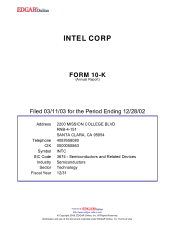Intel 2002 Annual Report Download - page 10
Download and view the complete annual report
Please find page 10 of the 2002 Intel annual report below. You can navigate through the pages in the report by either clicking on the pages listed below, or by using the keyword search tool below to find specific information within the annual report.
consumption requirements for 10-Gigabit optical transceivers used in enterprise applications.
Network Processing Components
The Intel® Internet Exchange Architecture (Intel® IXA) provides a flexible platform for the networking and communications industry to
build faster, more intelligent networks using reprogrammable silicon. Our network processor products consist of advanced, programmable
devices that are used in networking equipment to rapidly manage and direct data moving across the Internet and corporate networks. Our
strategy in network processing is to develop an industry-leading product roadmap, invest in modular communications standards and enable
activities to accelerate silicon deployment.
In February 2002, we unveiled a family of network processors based on the Intel XScale core microarchitecture. These network processors
are designed for applications extending from the home and office to service providers' central switching offices and include the Intel® IXP2800
network processor for network core applications, such as ultra-high-speed switch/routers; the Intel® IXP2400 network processor for multi-
service switches and similar equipment at the network edge; and the Intel® IXP425 network processor for equipment that brings digital
subscriber line (DSL) service, cable Internet service and wireless networking to homes and offices. In February 2003, we introduced the Intel®
IXP 420, IXP 421 and IXP 422 network processors for equipment aimed at home, small office/home office (SOHO) and small- to medium-
enterprise market segments.
In September 2002, we expanded our communications processing product portfolio with two new processors for communications
equipment manufacturers: the Intel® IXC1100 control-plane processor, our first control-plane processor based on the Intel XScale technology,
and the low-voltage Intel Xeon applications and services processor. These chips combine integrated technologies with low power consumption
for communications and wireless infrastructure equipment.
In October 2002, we introduced the Intel® IXP2850 network processor, which builds on the Intel IXP2800 network processor architecture
to provide added encryption and data integrity standards, allowing for more secure content processing for applications such as virtual private
networks and web services.
Embedded Control Chips
Our embedded control chips are used in a broad range of applications, including imaging products, storage media, point-of-sale systems,
industrial automation equipment and automotive systems. Product families include the Intel 186, Intel386™, Intel486™, Intel® Pentium® II,
and Intel® Pentium® III processors; the Intel® i960® processor; and 8-bit and 16-bit microcontrollers. In June 2002, Intel added the Mobile
Intel Pentium 4 Processor-M and the Intel Pentium 4 processor to its line-up of embedded processors, for use in high-performance embedded
computing solutions such as virtual private networks, firewalls, point-of-sale terminals and kiosk applications.
Manufacturing, Assembly and Test
As of year-end 2002, more than 70% of our wafer manufacturing, including microprocessor, flash memory and networking silicon
fabrication, was conducted within the United States at our facilities in Arizona, Oregon, New Mexico, Massachusetts, Colorado and California.
Outside the United States, almost 30% of our total wafer fabrication, primarily microprocessor and chipset fabrication, was conducted at our
facilities in Israel and Ireland.
8
As of year-end 2002, the majority of our microprocessors and chipsets was manufactured using our 0.13-micron process technology, on
200mm (8-inch) wafers, in Oregon, Arizona, Massachusetts and California. The latest Pentium 4 processors are manufactured using our 0.13-
micron process technology. The 0.13-micron process technology is our most advanced high-volume production process featuring structures
smaller than 1/1000th the thickness of a human hair (0.18 micron is 1/500th the thickness of a human hair). We also continue to manufacture
microprocessors and chipsets using our 0.18-micron process technology in Israel, Ireland, Arizona and New Mexico.
In 2002, we brought on line our second 300mm (12-inch) wafer fabrication facility in New Mexico. Both our New Mexico and Oregon
300mm facilities currently manufacture processors based on 0.13-micron process technology. In the third quarter of 2002, we announced plans
to begin manufacturing processors on 300mm wafers using our next-generation 90-nanometer (a nanometer is one-billionth of a meter) process
technology in the second half of 2003. We expect to have three 300mm wafer facilities using the 90-nanometer process by the end of 2004, with
the third facility under construction in Ireland. We believe we are the first company to complete development of 90-nanometer process
technology and to demonstrate manufacturing readiness with complex integrated circuits. We also announced plans for two additional 300mm
facilities in Oregon and Arizona that will start production after 2004.
During 2002, we ramped our flash memory production using 0.13-micron process technology in New Mexico and California. In the first
half of 2003, we intend to ramp flash memory production using 0.13-micron process technology in Ireland. We also manufacture flash memory
in Colorado and New Mexico using our 0.18
-
micron technology.























